The Development of Social Bonds
One resounding conclusion of research in the social sciences is that humans, from the first days of life to the last, are powerfully influenced by other humans. Social bonds affect health and happiness at every age (Hazan & Campa, 2013). Evidence of this in infancy depends partly on the age of the baby. First synchrony, then attachment, and finally social referencing are apparent (see Visualizing Development, p. 144).

Synchrony
synchrony
A coordinated, rapid, and smooth exchange of responses between a caregiver and an infant.
Ideally, early parent–
BOTH PARTNERS ACTIVE Direct observation reveals synchrony. Anyone can see it when watching a caregiver play with an infant who is too young to talk. It is also evident in computer measurement of the millisecond timing of smiles, arched eyebrows, and so on (Messinger et al., 2010). Synchrony is a powerful learning experience for the new human. Infants read others’ emotions and develop social skills, taking turns and watching expressions.
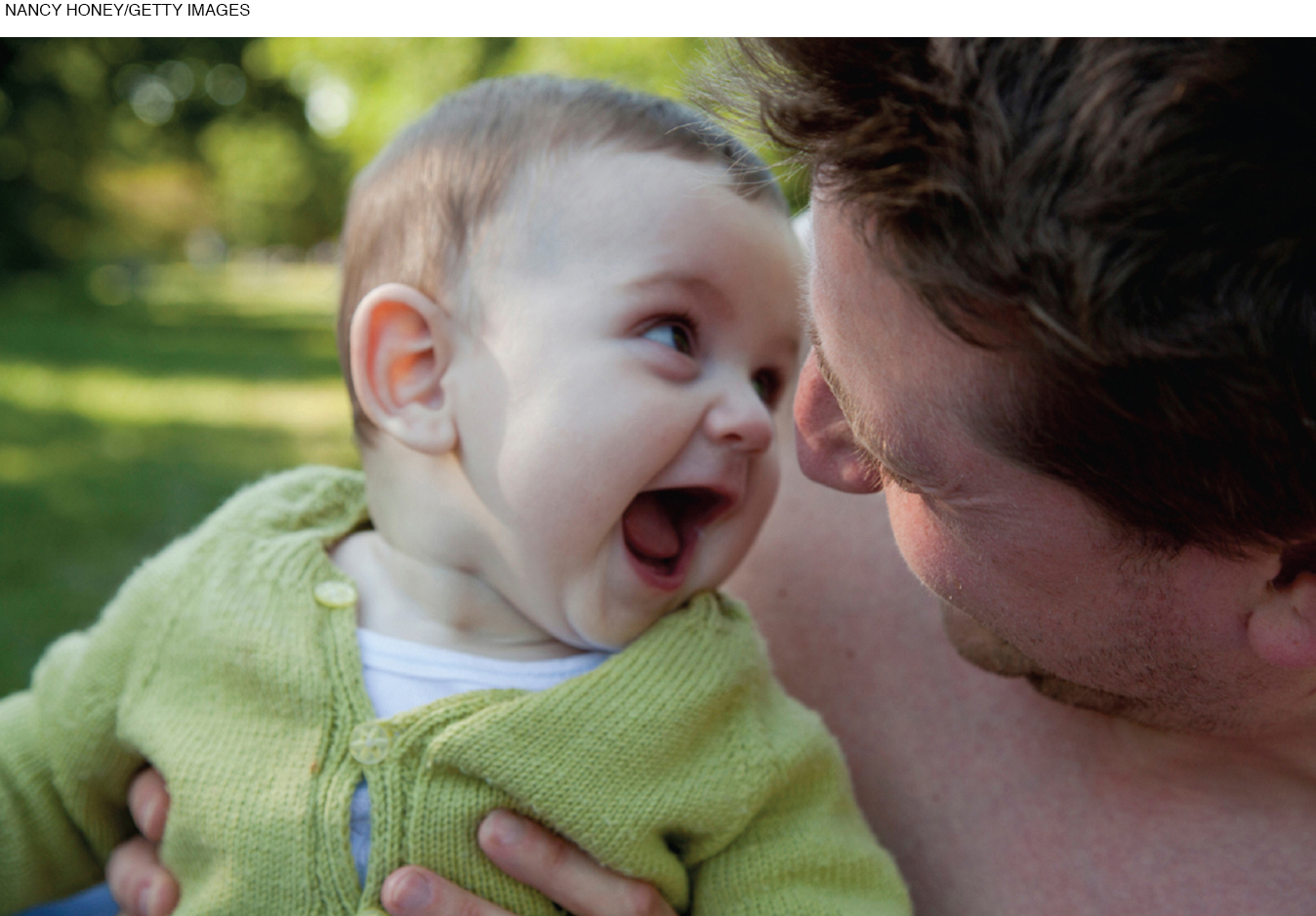
Thus, long before they can reach out and grab, infants respond excitedly to caregiver attention by waving their arms. They are delighted if the adult moves closer so that a waving arm can touch the face or, even better, a hand can grab hair. You read about this eagerness for interaction (when infants try to “make interesting events last”) in Chapter 3.
In response, adults open their eyes wide, raise their eyebrows, smack their lips, and emit nonsense sounds. Hair-
Synchrony usually begins with adults imitating infants (not vice versa), with tone and rhythm (Van Puyvelde et al., 2010). Adults respond to barely perceptible infant facial expressions and body motions. This helps infants connect their internal state with behaviors that are understood within their culture.
THINK CRITICALLY: What will happen if no one plays with an infant?
Ideally, parents and infants become partners. This relationship is crucial when the infant is at medical risk. The necessity of time-
still-
An experimental practice in which an adult keeps his or her face unmoving and expressionless in face-
NEGLECTED SYNCHRONY In the still-
Then the adult stops all expression on cue, staring quietly with a “still face” for a minute or two. Sometimes by 2 months, and clearly by 6 months, infants are upset when their parents are unresponsive. Babies frown, fuss, drool, look away, kick, cry, or suck their fingers. By 5 months, they also vocalize, as if to say, “React to me” (Goldstein et al., 2009).
Many studies of still faces and other interactions reach the same conclusion: Synchrony is experience-
For example, one study looked in detail at 4-
When the mothers were still-
The mothers of each type differed, with the engaged mothers matching the infants’ actions (bobbing head, opening mouth, and so on) and the negative mothers almost never matching. The researchers suggest that the “distinctive patterns of infants’ individual differences” determined the mothers’ behavior (Montirosso et al., 2015, p. 67). However, as was already explained, other researchers would do the opposite, with mothers determining the infants’ behavior. Either way, a lack of synchrony is a troubling sign.
Attachment
Toward the end of the first year, face-
attachment
According to Ainsworth, “an affectional tie” that an infant forms with a caregiver—
Instead attachment becomes evident. Actually, as thousands of researchers on every continent have shown, attachment is lifelong, beginning before birth and influencing relationships throughout life (see At About This Time).
Attachment has been studied with atypical populations (e.g., infants with Down syndrome, with autism spectrum disorder, and so on), with teenagers, and with adults (Simpson & Rholes, 2015; K. Grossmann et al., 2014). This field of study was inspired by John Bowlby’s theories (1982, 1983) and by Mary Ainsworth, who described mother–
SIGNS OF ATTACHMENT As Ainsworth noted, infants show their attachment through proximity-
|
Birth to 6 weeks Preattachment. Newborns signal, via crying and body movements, that they need others. When people respond positively, the newborn is comforted and learns to seek more interaction. Newborns are also primed by brain patterns to recognize familiar voices and faces. 6 weeks to 8 months Attachment in the making. Infants respond preferentially to familiar people by smiling, laughing, babbling. Their caregivers’ voices, touch, expressions, and gestures are comforting, often overriding the infant’s impulse to cry. Trust (Erikson) develops. 8 months to 2 years Classic secure attachment. Infants greet their primary caregivers, play happily when they are present, show separation anxiety when their primary caregivers leave. Both infant and caregiver seek to be close to each other (proximity) and frequently look at each other (contact). In many caregiver– 2 to 6 years Attachment as launching pad. Young children seek their caregivers’ praise and reassurance as their social world expands. Interactive conversations and games (hide- 6 to 12 years Mutual attachment. Children seek to make their caregivers proud by learning whatever adults want them to learn, and adults reciprocate. In concrete operational thought (Piaget), specific accomplishments are valued by adults and children. 12 to 18 years New attachment figures. Teenagers explore and make friendships independent from parents, using their working models of earlier attachments as a base. With formal operational thinking (Piaget), shared ideals and goals become influential. 18 years on Attachment revisited. Adults develop relationships with others, especially relationships with romantic partners and their own children, influenced by earlier attachment patterns. Past insecure attachments from childhood can be repaired rather than repeated, although this does not always happen. |
Data from Grobman, 2008.

Video Activity: Mother Love: The Work of Harry Harlow features classic footage of Harlow’s research, showing the setup and results of his favorite experiment.
Some caregivers take the baby into the bathroom, leading to one mother’s complaint that she hadn’t been alone in the bathroom for two years (Senior, 2014). Often caregivers sing and talk to the baby when they are out of sight. Maintaining contact need not be physical: Visual or verbal connections can express attachment. Later on, in adulthood, a phone call or a text message may be enough.
Caregivers show many signs that attachment is mutual. They keep a watchful eye on their baby, and they elicit interaction with expressions, gestures, and sounds. Before going to sleep at midnight they might tiptoe to the crib to gaze at their sleeping infant, or, in daytime, absentmindedly smooth their toddler’s hair.
Attachment is universal, being part of the inborn social nature of the human species. The particular ways it is expressed depend on culture. For instance, Ainsworth reported that Ugandan mothers never kiss their infants, but they often massage them, contrary to Westerners.
Some adults remain in contact simply by sitting in the same room as each reads quietly. In some cultures, adults often hold hands, hug, or touch each other’s faces, shoulders, or buttocks. Some scholars believe that attachment, not only with mothers but also fathers, grandparents, and nonrelatives, is one reason that Homo sapiens thrived when other species became extinct (Hrdy, 2009).
secure attachment
A relationship in which an infant obtains both comfort and confidence from the presence of his or her caregiver.
SECURE AND INSECURE ATTACHMENT Attachment is classified into four types: A, B, C, and D (see Table 4.1). Infants with secure attachment (type B) feel comfortable and confident. The caregiver is a base for exploration, providing assurance and enabling discovery. A toddler might, for example, scramble down from the caregiver’s lap to play with an intriguing toy but periodically look back and vocalize (contact-
insecure-
A pattern of attachment in which an infant avoids connection with the caregiver, as when the infant seems not to care about the caregiver’s presence, departure, or return.
insecure-
A pattern of attachment in which an infant’s anxiety and uncertainty are evident, as when the infant becomes very upset at separation from the caregiver, such infants both resist and seek contact on reunion.
By contrast, insecure attachment (types A and C) is characterized by fear, anxiety, anger, or indifference. Some insecure children play independently without maintaining contact; this is insecure-
disorganized attachment
A type of attachment that is marked by an infant’s inconsistent reactions to the caregiver’s departure and return.
Ainsworth’s original schema differentiated only types A, B, and C. Later researchers discovered a fourth category (type D), disorganized attachment. Type D infants may shift suddenly from hitting to kissing their mothers, from staring blankly to crying hysterically, from pinching themselves to freezing in place.
Among the general population, almost two-
| Type | Name of Pattern | In Playroom | Mother Leaves | Mother Returns | Toddlers in Category (%) |
|---|---|---|---|---|---|
| A | Insecure- |
Child plays happily. | Child continues playing. | Child ignores her. | 10– |
| B | Secure | Child plays happily. | Child pauses, is not as happy. | Child welcomes her, returns to play. | 50– |
| C | Insecure- |
Child clings, is preoccupied with mother. | Child is unhappy, may stop playing. | Child is angry; may cry, hit mother, cling. | 10– |
| D | Disorganized | Child is cautious. | Child may stare or yell; looks scared, confused. | Child acts oddly; may scream, hit self, throw things. | 5– |
About one-
strange Situation
A laboratory procedure for measuring attachment by evoking infants’ reactions to the stress of various adults’ comings and goings in an unfamiliar playroom.
MEASURING ATTACHMENT Ainsworth (1973) developed a now-
Researchers are trained to distinguish types A, B, C, and D. They focus on the following:
Exploration of the toys. A secure toddler plays happily.
Reaction to the caregiver’s departure. A secure toddler shows some sign of dismay when the caregiver leaves.
Reaction to the caregiver’s return. A secure toddler welcomes the caregiver’s reappearance, usually seeking contact, and then plays again.
Attachment is not always measured via the Strange Situation; surveys and interviews are also used. Sometimes parents answer 90 questions about their children’s characteristics, and sometimes adults are interviewed extensively (according to a detailed protocol) about their relationships with their own parents, again with various specific measurements. Attachment can be assessed in middle school children, adolescents who are dating, and with an entire family, via verbal responses or actions (Farnfield & Holmes, 2014).
Research measuring attachment has revealed that some behaviors that might seem normal are, in fact, a sign of insecurity. For instance, an infant who clings to the caregiver and refuses to explore the toys might be type C. Likewise, adults who say their childhood was happy and their mother was a saint, especially if they provide few specific memories, might be insecure. And young children who are immediately friendly to strangers may never have formed a secure attachment (Tarullo et al., 2011).
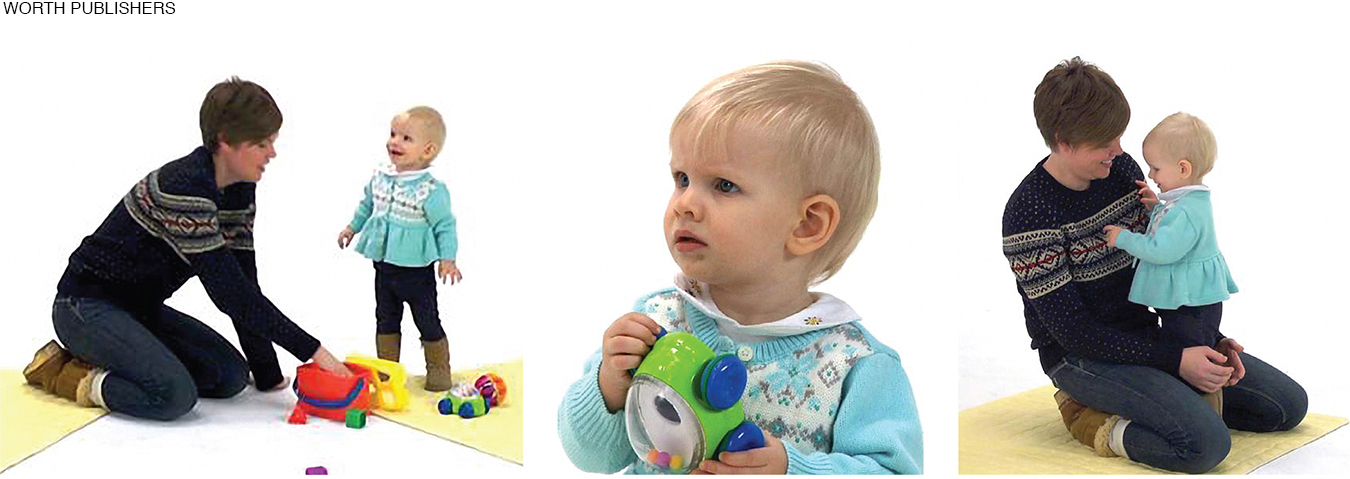
Assessments of attachment that were developed and validated for middle-
Insecure Attachment and the Social Setting
At first, developmentalists expected secure attachment in infancy to “predict all the outcomes reasonably expected from a well-
Securely attached infants are more likely to become secure toddlers, competent preschoolers, high-
Although attachment patterns form in infancy (see Table 4.2), they are not set in stone; a securely attached infant may become insecure if the family context changes, such as with new abuse or income loss. Poverty increases the likelihood of insecure attachment, and insecure attachment correlates with later learning problems, but a third variable may be the reason for this correlation.
The third variable most often suggested is low SES. Hostile children, fearful adults, delayed language, and low school achievement all correlate with low parental education, as does insecure attachment. The premise—
Certainly infant responses in the Strange Situation are only one measure of the parent–
|
Secure attachment (type B) is more likely if:
Insecure attachment is more likely if:
|
Question 4.14
OBSERVATION QUIZ
What three possible dangers do you see?
Social isolation (the sheet around the crib), lead poisoning (note that two babies are biting the painted bars), and injured limbs or even strangulation (note the bent crib slats, farther apart than U.S. law allows).
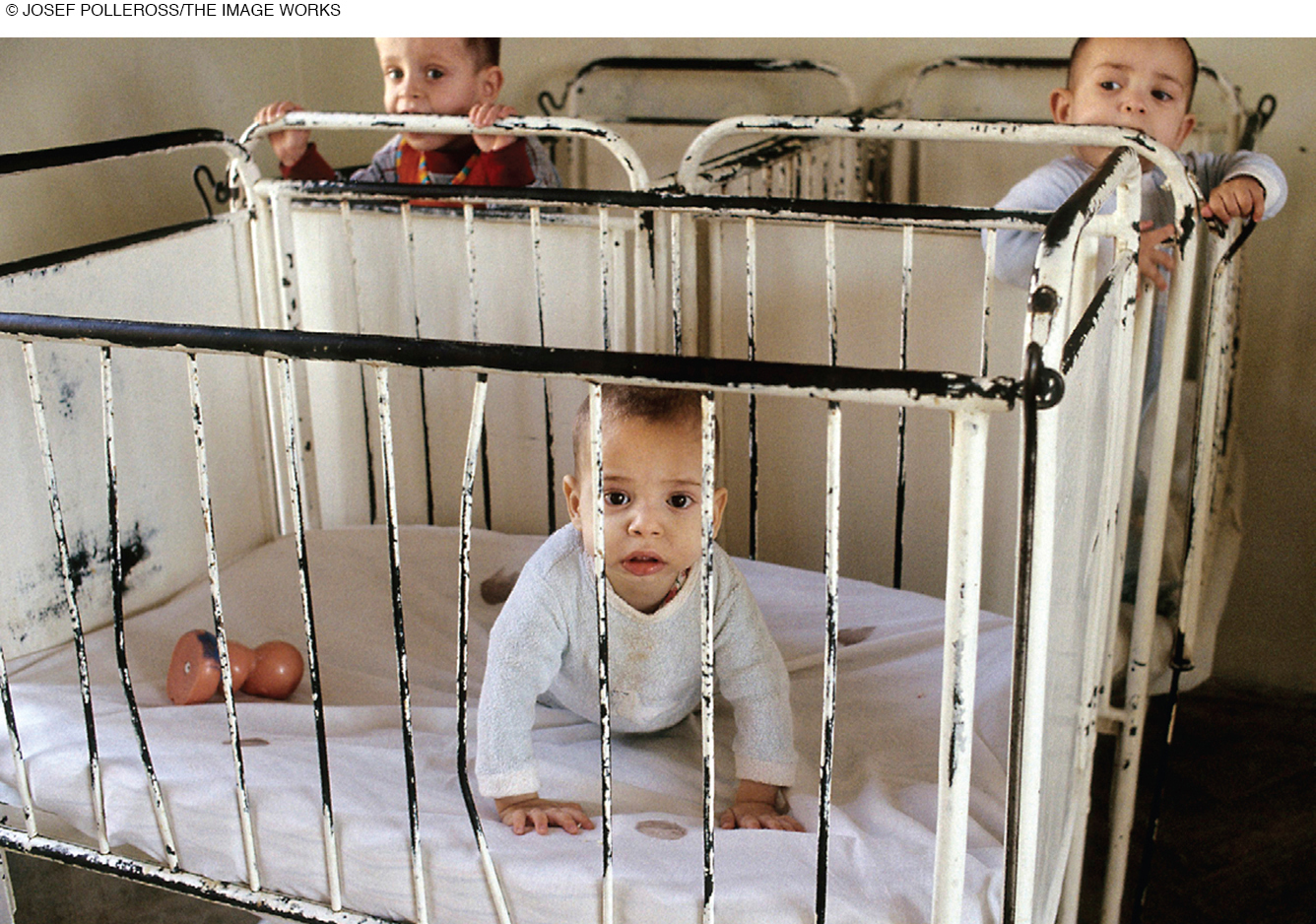
INSIGHTS FROM ROMANIA No scholar doubts that close human relationships should develop in the first year of life and that the lack of such relationships risks dire consequences. Unfortunately, thousands of children born in Romania are proof.
When Romanian dictator Nicolae Ceausesçu forbade birth control and abortions in the 1980s, illegal abortions became a leading cause of death for Romanian women aged 15 to 45 (Verona, 2003), and more than 100,000 children were abandoned to crowded, impersonal, state-
In the two years after Ceausesçu was ousted and killed in 1989, thousands of those children were adopted by North American, western European, and Australian families. Those who were adopted before 6 months of age fared best; the adoptive parents established synchrony via play and caregiving. Most of them developed normally.
For those adopted after 6 months, and especially after 12 months, early signs were encouraging: Skinny infants gained weight and grew faster than other 1-
Even those who were well nourished or who caught up to normal growth often became impulsive, angry teenagers. Apparently, the stresses of adolescence and emerging adulthood exacerbated the cognitive and social strains on these young people and their families (Merz & McCall, 2011).
These children are now adults, some with serious emotional or conduct problems. The cause is more social than biological. Research on children adopted nationally and internationally finds that many become normal adults, but every stress—
Romanian infants are no longer available for international adoption, even though some remain abandoned. Research confirms that early emotional deprivation, not genes or nutrition, is their greatest problem. Romanian infants develop best in their own families, second best in foster families, and worst in institutions (Nelson et al., 2007).
As best we know, this applies to infants everywhere: Families usually nurture their babies better than strangers who care for many infants at once, and the more years children spend in an impersonal institution, the more likely it is they will become socially and intellectually impaired (Julian, 2013).

Fortunately, in eastern Europe and elsewhere, institutions have improved or been shuttered; recent international adoptees (often now from Central America or sub-
However, some infants in every nation are deprived of healthy interaction, sometimes within their own families. Ideally, no infant is institutionalized, but if that ideal is not reached, institutions need to change so that psychological health is as important as physical health (McCall, 2013). Children need responsive caregivers, who could be their biological relatives but could be unrelated. When international adoptions become a pawn in international disputes, as in 2014 between the United States and Russia, children suffer.
PREVENTING PROBLEMS All infants need love and stimulation; all seek synchrony and then attachment—
Since synchrony and attachment develop over the first year, and since more than one-

THINK CRITICALLY: Is the Strange Situation a valid way to measure attachment in every culture, or is it biased toward Western idea of the ideal mother–
Some birth parents, fearing that they cannot provide responsive parenting, choose adoptive parents. This is best done at birth so that synchrony and attachment can develop (McCall, 2013). If high-
Social Referencing
social referencing
Seeking information about how to react to an unfamiliar or ambiguous object or event by observing someone else’s expressions and reactions. That other person becomes a social reference.
Social referencing refers to seeking emotional responses or information from other people, much as a student might consult a dictionary or other reference work. Someone’s reassuring glance, cautionary words, or a facial expression of alarm, pleasure, or dismay—
Even at 8 months, infants notice where other people are looking and use that information to look in the same direction themselves (Tummeltshammer et al., 2014). After age 1, when infants can walk and are “little scientists,” their need to consult others becomes urgent as well as more accurate.
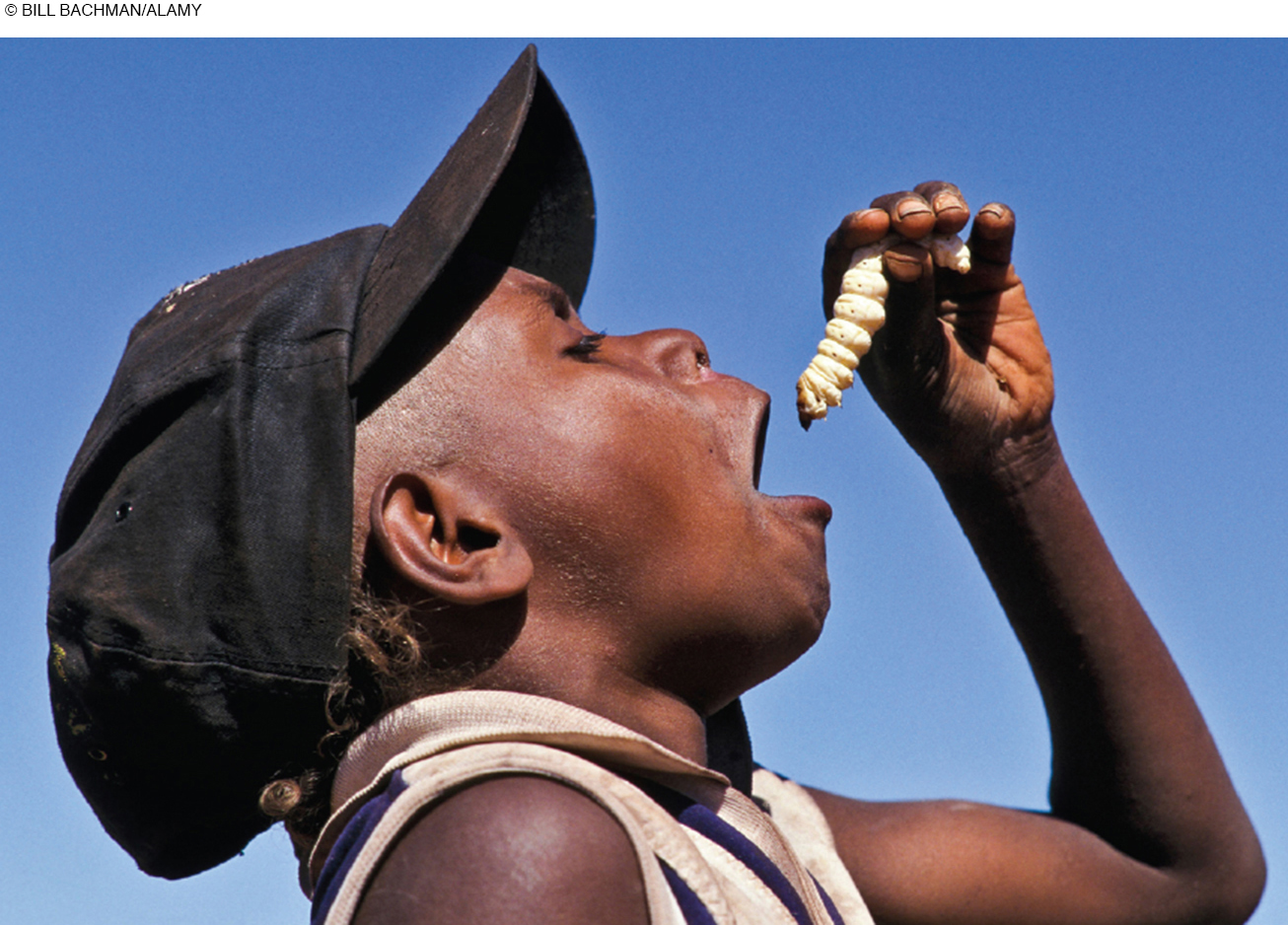
Toddlers search for clues in gazes, faces, and body positions, paying close attention to emotions and intentions. They focus on their familiar caregivers, but they also use relatives, other children, and even strangers to help them assess objects and events. They are remarkably selective, noticing that some strangers are reliable references and others are not (Fusaro & Harris, 2013).
Social referencing has many practical applications. Consider mealtime. Caregivers the world over smack their lips, pretend to taste, and say “yum-
Through this process, some children develop a taste for raw fish or curried goat or smelly cheese—
Fathers as Social Partners
Fathers enhance their children’s social and emotional development in many ways (Lamb, 2010). Synchrony, attachment, and social referencing are sometimes more apparent with fathers than with mothers. Fathers typically elicit more smiles and laughter from their infants than mothers do, probably because they play more exciting games, while mothers do more caregiving and comforting (Fletcher et al., 2013).
When asked to play with their baby, mothers typically caress, read, sing, or play traditional games such as peek-
ETHNIC AND CULTURAL DIFFERENCES Some people still hold the prejudice that African American, Latin American, and Asian American fathers are less nurturing and more strict than other men. In fact, the opposite may be true (Parke, 2013).
Within every ethnic group in the United States, contemporary fathers tend to be more involved with their infants than fathers once were. Fathers are also affected by income (stressed parents are less nurturing) and by where they live. As with humans of all age, social contexts are influential: Fathers are influenced by other fathers (Roopnarine & Hossain, 2013; Qin & Chang, 2013). Thus, fathers of every ethnic group are aware of what other men are doing, and that affects their own behavior.
Close father–
Less rigid gender roles seem to be developing in every nation, allowing a greater caregiving role for fathers (Shwalb et al., 2013). One U.S. example of historical change is the number of married women with children under age 6 who are employed. In 1970, 30 percent of married mothers of young children earned paychecks; in 2012, 60 percent did (U.S. Bureau of Labor Statistics, 2013). These statistics include many mothers of infants, who often rely on the baby’s father for child care.
Note the reference to “married” mothers: About half new mothers of infants in the United States are not married, and their employment rates are higher than their married counterparts. Their baby’s father—
allocare
Literally, “other-
The fact that father involvement with infants varies by culture, and that fathers tend to be more involved than they were a few decades ago, should not obscure another truth—
Compared with many other species (for instance, mother chimpanzees never let another chimp hold their babies), human mothers have evolved to let other people help with child care, and other people are usually eager to do so (Kachel et al., 2011). Throughout the centuries, the particular person to provide allocare has varied by culture and ecological conditions.


Often fathers helped but not always: Some men were far away, fighting, hunting, or seeking work, while some had several wives and a dozen or more children. In those situations, other women (daughters, grandmothers, sisters, friends) and sometimes other men provided allocare (Hrdy, 2009).
FAMILY COOPERATION Fathers and mothers often work together to raise the children. One researcher reports “mothers and fathers showed patterns of striking similarity: they touched, looked, vocalized, rocked, and kissed their newborns equally” (Parke, 2013, p. 121). Differences were apparent from one couple to another, but not from one gender to another—
Children benefit when both parents are caregivers. It is still true, in every culture and ethnic group, that the average father spends much less time with infants than mothers do (Parke, 2013; Tudge, 2008). Some women are gatekeepers, believing that child care is their special domain. They imply that fathers are incompetent (perhaps saying, “You’re not holding her right”), laying out the clothes the baby is to wear, as if the father could not find clothes on his own (Pedersen & Kilzer, 2014).
Over the past 20 years, father–
Can men provide care for infants as well as women can?
Is father–
infant interaction different from mother– infant interaction? How do fathers and mothers cooperate to provide infant care?
Many studies over the past two decades have answered yes to the first two questions. A baby fed, bathed, and diapered by Dad is just as happy and clean as when Mom does it. Gender differences are sometimes found in details, but babies thrive in father-
On the third question, the answer depends on the family (Bretherton, 2010). Usually, mothers are caregivers and fathers are playmates, but not always. Each couple, given their circumstances (perhaps immigrant, low-
A constructive parental alliance can take many forms, but it cannot be taken for granted, no matter what the family configuration. Single-
A CASE TO STUDY
Can We Bear This Commitment?
Parents and children capture my attention, wherever they are. Today I saw one mother ignoring her stroller-
I particularly observe families I know. I am struck by the powerful bond between parent and child, as strong or stronger in adoptive families as in genetic ones.
One adoptive couple is Macky and Nick with their two daughters. I see them echoing my own experiences with my four. Two examples: When Alice was a few days old, I overheard Nick phone another parent, asking which detergent is best for washing baby clothes. Another time, when Macky was engrossed in conversation, Nick interrupted him to insist it was time to get the girls home for their nap.
My appreciation of their attachment was cemented by a third incident. In Macky’s words:
I’ll never forget the Fourth of July at the spacious home of my mother-
My husband and I have two daughters, Alice who was then 7 and Penelope who was 4. They learned to swim early and are always the first to jump in the pool and the last to leave. Great children, even if their parents have dropped the ball a time or two.
After hours of swimming, the four of us scrambled up to dry land. We walked across the long lawn to join the lunching folk and enjoy hot dogs, relish, mustard, and juicy watermelon.
Suddenly we heard a heart-
He lived. He regained his breath and was whisked away by ambulance. The party came to a quick close.
We four, skin tingling from the summer sun, hearts beating from the near-
Turning to Nick, I asked: “Can we bear this commitment we have made? Can we raise our children in the face of all hazards—
That was five years ago. Our children are flourishing. Our confidence is strong and so are our emotions. But it takes only a moment to recognize just how entwined our well-

Sometimes no one provides good care. One study reported that 7 percent of fathers of 1-
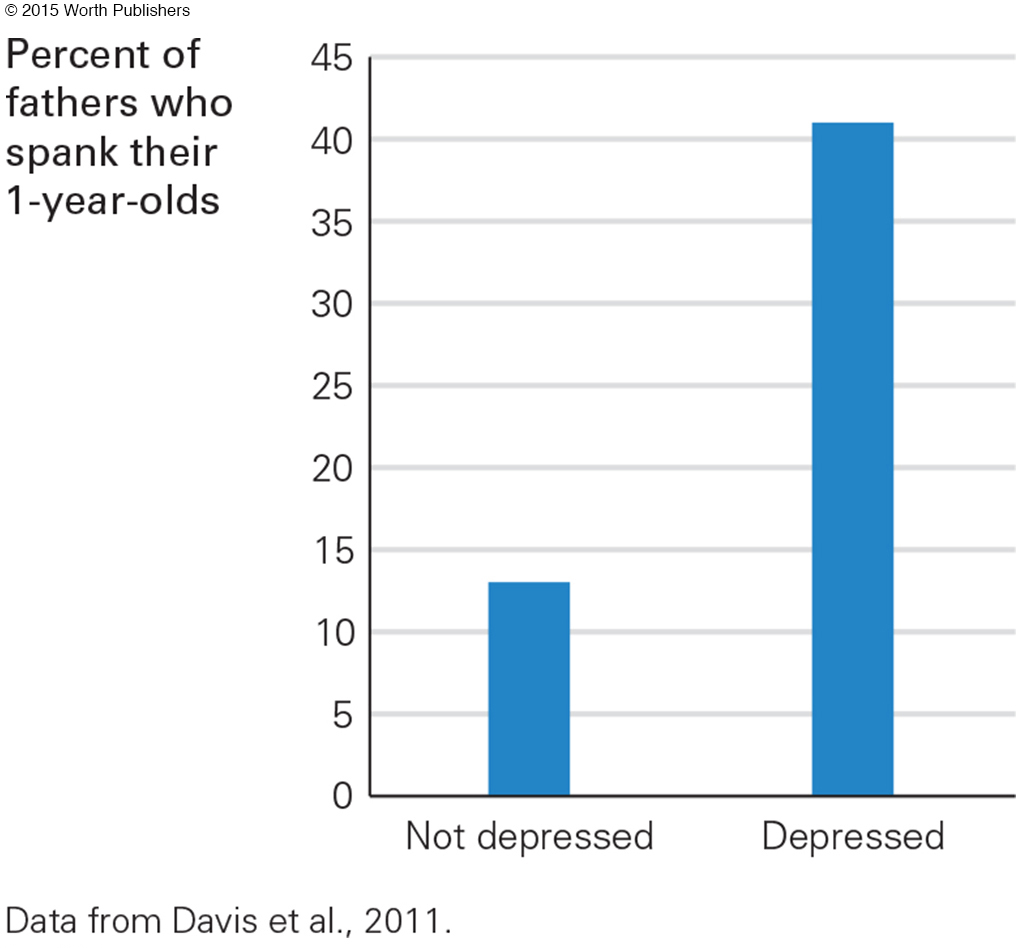
Family members affect each other. Paternal depression correlates with maternal depression and with sad, angry, disobedient toddlers. Cause and consequence are intertwined. When anyone is depressed or hostile, everyone (mother, father, baby, sibling) needs help.
WHAT HAVE YOU LEARNED?
Question 4.15
1. How might synchrony affect early emotional development?
Parental responsiveness during synchrony aids psychosocial and biological development by providing powerful learning experiences. With every parental interaction, infants learn to read another’s facial expression, body language, and emotions, thereby laying the foundation for the development of social skills.
Question 4.16
2. What would an infant do to demonstrate attachment?
Infants show their attachment through proximity-
Question 4.17
3. How would a caregiver try to maintain proximity and contact?
To maintain proximity, some caregivers may sing and talk to their infant when they are out of sight; they may also take their infants wherever they go, even the bathroom. Examples of contact-
Question 4.18
4. How would a type B secure adult act in a romantic relationship?
They tend to have good relationships and good self-
Question 4.19
5. How would a type A insecure adult act in a romantic relationship?
They tend to be aloof in personal relationships.
Question 4.20
6. How would a type C insecure adult act in a romantic relationship?
Their relationships may be angry, stormy, and unpredictable.
Question 4.21
7. How do negative circumstances (e.g., divorce, abuse, low SES) affect attachment?
Negative circumstances such as abuse, income loss, poverty, and low SES increase the likelihood of insecure attachment. Insecure attachment can correlate with later learning problems, delayed language, low school achievement, and hostile children. Although attachment patterns form in infancy, they are not set in stone; a securely attached infant may become insecure if the family context changes.
Question 4.22
8. What can be done to improve the parent–
We know that secure attachment is more difficult to achieve when the parents were abused as children, when families are socially isolated, when mothers are young adolescents, or when infants are unusually difficult. All parents, but especially those classified as high-
Question 4.23
9. Whom do infants use as social references?
Typically, infants focus on their familiar caregivers, but they also use relatives, other children, and even strangers to help them assess objects and events. They are remarkably selective, noticing that some strangers are reliable references and others are not.
Question 4.24
10. Why is allocare necessary for survival of the human species?
Evolutionary social scientists note that if mothers were the exclusive caregivers of each child until children were adults, a given woman could only rear one or two offspring—
Question 4.25
11. How is father-
Fathers enhance their children’s social and emotional development in many ways as mothers do, and synchrony, attachment, and social referencing are all apparent with fathers.
Question 4.26
12. How does father-
Fathers typically elicit more smiles and laughter from infants than mothers do, engaging more often in exciting and active play. Close father-
Question 4.27
13. What ethnic and cohort differences are apparent in father-
Within every ethnic group in the United States, contemporary fathers tend to be more involved with their infants than fathers once were. Fathers are also affected by income (stressed parents are less nurturing) and by where they live. As with humans of all age, social contexts are influential: Fathers are influenced by other fathers. Thus, fathers of every ethnic group are aware of what other men are doing, which affects their own behavior.